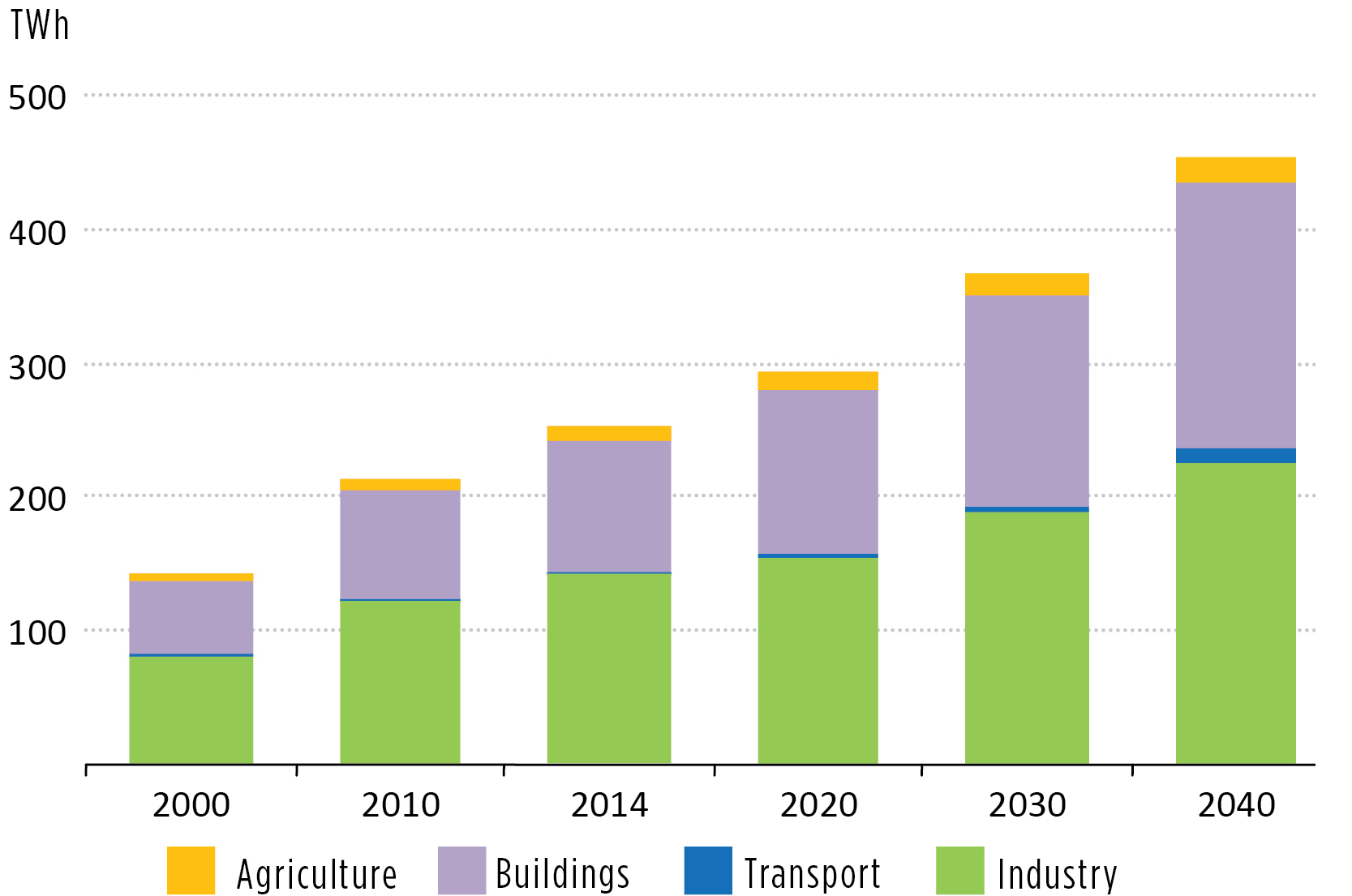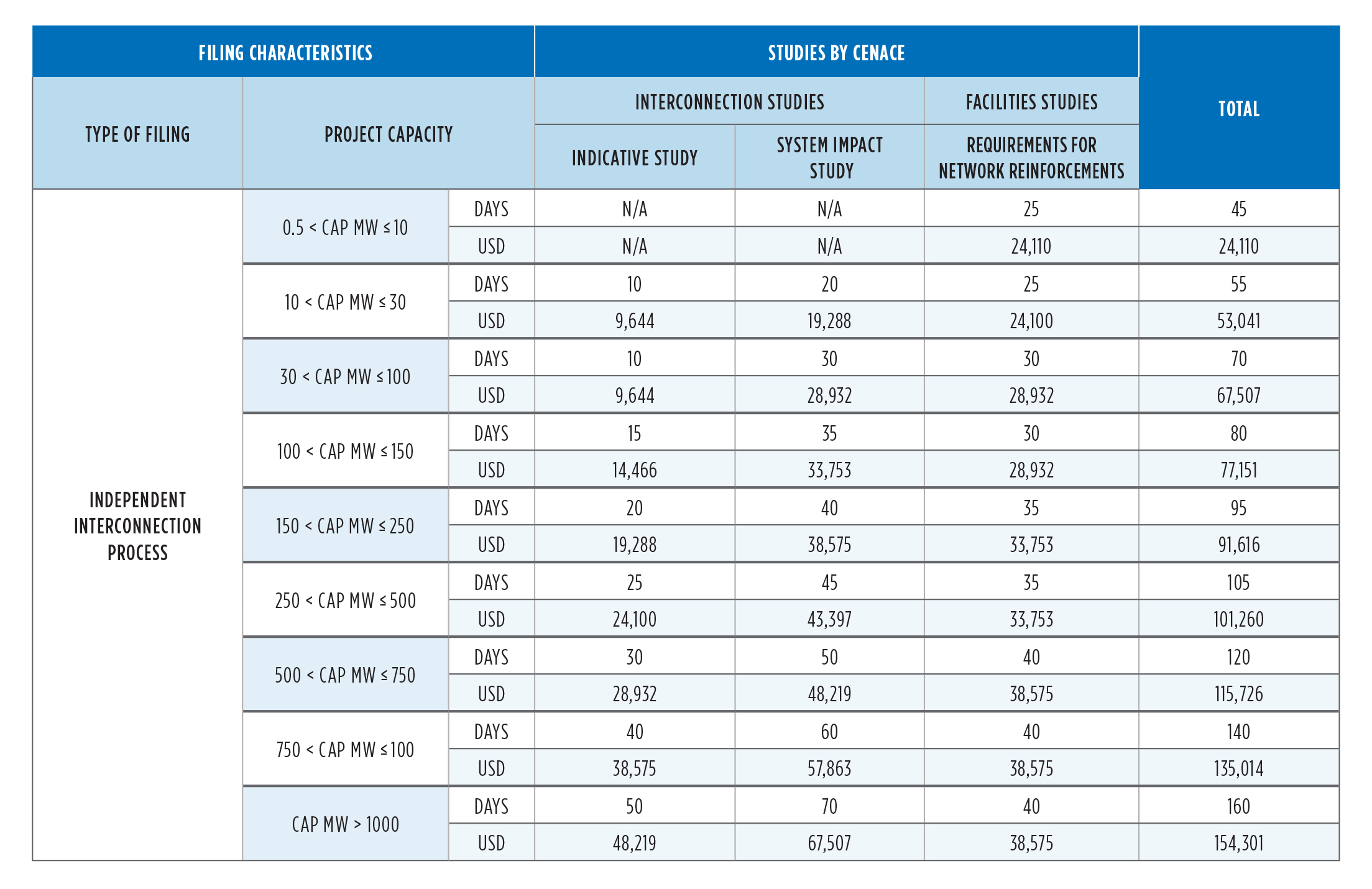WHITE PAPER / CHOOSING THE RIGHT GRID INTERCONNECTION PROJECTS TO PURSUE
Energy reforms have made Mexico’s power market enticing for investors and developers, generating significant competition. Developers and investors can gain an edge through proactive grid interconnection assessments that provide better cost certainty when taking power projects to auction.
✖
✖
In 2013, Mexico enacted numerous energy reforms to increase private sector investment within its energy sector and reduce consumer costs. As part of those reforms, Mexico increased its renewable energy goals and is working to obtain 35 percent of its power needs from renewable resources by 2024, and 50 percent by 2050. Furthermore, according to the International Energy Administration (IEA), energy consumption is growing at a sustained rate across virtually all industries in Mexico (Figure 1). At the same time, the IEA projects tremendous change in generator capacity and the overall energy portfolio as the country moves away from oil and coal-fueled generation to natural gas, wind and solar (Figure 2).

FIGURE 1: Projected energy consumption by sector in Mexico. Source: IEA Mexico Energy Outlook.

FIGURE 2: Projected change in generator capacity for Mexico. Source: IEA Mexico Energy Outlook.
In 2013, Mexico enacted numerous energy reforms to increase private sector investment within its energy sector and reduce consumer costs. As part of those reforms, Mexico increased its renewable energy goals and is working to obtain 35 percent of its power needs from renewable resources by 2024, and 50 percent by 2050. Furthermore, according to the International Energy Administration (IEA), energy consumption is growing at a sustained rate across virtually all industries in Mexico (Figure 1). At the same time, the IEA projects tremendous change in generator capacity and the overall energy portfolio as the country moves away from oil and coal-fueled generation to natural gas, wind and solar (Figure 2).

FIGURE 1: Projected energy consumption by sector in Mexico. Source: IEA Mexico Energy Outlook.

FIGURE 2: Projected change in generator capacity for Mexico. Source: IEA Mexico Energy Outlook.
As the IEA projections show, the opportunity to invest in new power production assets — renewables and natural gas — is apparent. The challenge, and a major cost consideration for developers, is finding locations that cost-effectively get that power to load centers.
The more competitive and lower cost your power project is, the more viable and attractive it will be to potential project purchasers. Intensity of a renewable resource, such as wind or solar, narrows site selection. However, available delivery infrastructure, such as transmission lines, also drives cost and can greatly impact the development schedule. Notably, proximity to existing transmission lines does not guarantee lower overall project costs.
CENACE, or the National Center for Energy Control, is the public body responsible for sending economic dispatch signals to participating generators and operating and controlling Mexico’s national transmission grid. It is also tasked with overseeing the wholesale electricity market; planning expansions and upgrades of the national transmission grid; and establishing the infrastructure and technical requirements that enable open access for the interconnection of generation and connection of load centers.
In early 2018, the Mexican Ministry of Energy, known as SENER and responsible for conducting national energy policies and promoting research and sustainability, issued a manual that outlines the process to apply and obtain approval for power plants to interconnect with the national grid. All interconnection applications are handled through CENACE’s online system (SIASIC). The manual requires three levels of studies: indicative study, system impact study, and a facilities study. Every developer, for every generation or load project and/or site location, must submit an interconnection study request to CENACE for each interconnection request. This process limits an applicant’s ability to request technical clarifications to just one for each study. Applicants also have a limited amount of time to respond to CENACE’s study requests and move on to the next phase of studies, at the risk of having the interconnection site dropped from the request queue.
In January 2019, CRE (the Energy Regulatory Commission) released an updated agreement that defines an interconnection process for energy storage. However, it has not yet defined a complete market for the regulatory services that storage can support.
Experience has shown that the complexity of the interconnection process should never be underestimated. Application unknowns, incomplete or undefined information, and political changes all impact the flow of the interconnection process. Figure 3 provides a summary table of the project costs and timelines associated with the CENACE application process.

FIGURE 3: Summary table of CENACE study costs and timeline for interconnection applications of various sizes. Prices are shown in U.S. dollars. Source: Interconnection Manual.
CENACE studies provide developers with a list of potential impacts and associated upgrades they must include in their project to mitigate those impacts prior to moving on to the next study level. Virtually every project will require some level of infrastructure upgrades that could, depending on the point of interconnection, range from a transformer upgrade to a new transmission line. The resulting identified upgrades and associated costs can greatly impact the viability of a generation project.
The more competitive and lower cost a project is, the more viable and attractive it will be to potential project sponsors. Three major site selection factors contribute to the viability of a project:
To better understand the existing grid infrastructure at the proposed point of interconnection for new power projects, preliminary grid assessments can be performed that replicate the CENACE process, providing a decision gate for viable project locations before requesting a formal interconnection study through CENACE. External Trusted Users (Usuarios Externos de Confianza) of CENACE’s Market Information System, including Burns & McDonnell, have access to CENACE’s transmission system and load growth models, which makes it possible to perform an indicative study similar to CENACE.
The interconnection application process centers on system reliability. Client parameters, such as size and location, can be entered into the model to identify system reliability impacts and potential mitigation requirements. This simulates what the CENACE indicative study results might look like, enabling clients to winnow their applications to those with fewer costs associated with impacts outside of the project fence. However, it is important to note that CENACE models are posted as of a specific point in time. Developers should also consider generation within the CENACE queue that could impact power flow in the future, as well as transmission facility rating assumptions.
Preliminary grid assessments can reduce cost and schedule risk throughout the CENACE process by avoiding submission of project studies that would trigger high system upgrade costs and by enabling proactive responses to time-sensitive study findings. Beyond interconnection impacts, developers of new power projects should also factor in present or future congestion and other costs associated with delivery of power to the end user. These are questions we can help address as a registered trusted user with access to the Market Information System’s power flow and market models.
Often, developers investigate and select multiple development sites based on resource and land availability, but don’t consider the availability of grid infrastructure until CENACE defines it during the interconnection process. However, preparing, submitting, monitoring, and responding to multiple interconnection applications is extremely labor intensive. The pre-indicative study helps developers converge on a single site with the optimal opportunity and lowest cost to pursue.
Due to the parallel nature of the three major site selection factors, developers can benefit from the flexibility of understanding grid interconnection information from pre-indicative studies before committing to the interconnection application schedule determined by CENACE. Obtaining this level of information on a developer’s own time without looming response deadlines can allow better analysis and planning for unexpected required upgrades. For example, Criterion 43 of the Interconnection Criteria Document says that an interconnection agreement must be signed 25 days after receiving the results of the facilities study.
Developers can also avoid penalties from CENACE for changes to their interconnection application. For example, increasing project capacity by less than 10 percent requires CENACE to perform a sensitivity analysis, delaying the interconnection process. A change of more than 10 percent requires a completely new application. Renewable energy clients are often interested in finding the maximum available injection capacity for a point of interconnection because of available wind and solar resources and additional nearby land available for purchase. Understanding this information before commencing the interconnection process can reduce change penalties and take advantage of grid availability and economies of scale.
Soliciting a pre-indicative study gives developers a degree of control over the study depth and assumptions. Developers often conduct internal investigations of site feasibility to some level. Working privately with a development consultant can make sure these preliminary investigations are utilized. For example, developers might have more market intel on other nearby energy projects in the interconnection queue, compared to the public data available from CENACE.
Additionally, the explanation of pre-indicative study results can be referenced and used as a defense against mismatching results during CENACE’s interconnection studies. Section 9.1.8 of the Interconnection Manual says that CENACE may consider the opinion of the applicant if other technical solutions constitute lower costs.
Developers and investors can gain an edge through proactive grid interconnection assessments by evaluating project feasibility before overinvesting. Pre-indicative studies identify the path-of-least-resistance projects that enable clients to focus investments, maintain flexibility, and increase control and understanding. The outcomes of such benefits are more profitable projects and the opportunity to more quickly grow investment portfolios.
Interested in learning more?
✖
© 2025 Burns & McDonnell. All Rights Reserved
At this time, Burns & McDonnell is not offering pure architectural services in the states of Illinois, Louisiana, Montana, Nevada, New Hampshire or New Jersey. We may, however, provide design-build services for architectural projects.